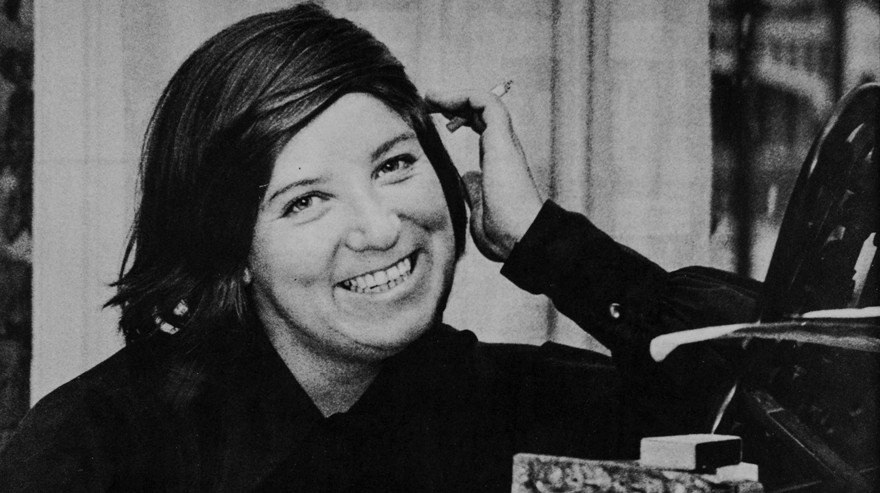
Jenny McLeod, photographed by Barry Woods for the Under the Sun booklet, 1971.
Jenny McLeod (1941-2022) was a musical prodigy who became an iconoclast. At the age of five, she could read music fluently. In 1970 – after studies in Europe with Stockhausen and Messaien – she was appointed New Zealand’s youngest full professor. She was 28. At Victoria University she continued the tradition established by Frederick Page and Douglas Lilburn that the music department would emphasise composition over performance. But she pushed it further, establishing courses in popular and non-western music. After six years, aged 35, she controversially resigned from the university to join the Maharaj Ji’s Divine Light Mission.
By the early 80s she returned to composition. Her oeuvre is vast, including an opera (Hōhepa), a film soundtrack (The Silent One), works for piano (the Tone Clock series), rock concertos, chamber groups, and children’s music. One example, ‘Goodnight, Christchurch’ (1985), was for three orchestras, a jazz band, and 400 recorders. More than any of her peers she championed the communal, communicative strengths of popular music. Two of her most well-known pieces were large-scale works for music theatre, Earth and Sky (1968) and Under the Sun (1971). This excerpt from Norman Meehan’s biography Jenny McLeod: A Life in Music (Te Herenga Waka University Press, 2023) describes the creation, performances, and reception to her music theatre work Under the Sun. Meehan writes, “The energy and unscripted qualities of improvisation [in Under the Sun] were further reasons for Jenny’s gradual move away from scored art music and towards popular forms.” – AudioCulture
--
The year Jenny McLeod assumed a professorial role at Victoria University, 1971, was also the centenary year for her mother’s home town, Palmerston North. Civic and community groups began planning events several years in advance of the celebrations.
Morva Croxson, a leader in establishing music therapy in New Zealand, was appointed to head the Palmerston North Centennial Music Committee. The mayor, Brian Elwood, suggested she “think big”. Hearing that Earth and Sky was to be performed in Masterton, Croxson and Helen Caskie, a friend and local composer, decided to go along. They “were very impressed, particularly noting the involvement of children. The whole thing was fresh and lively and honestly New Zealand.”
Captivated by what she had seen and heard, Croxson floated the idea of commissioning a work from Jenny for the centennial celebrations. The commission, which Jenny accepted, was not particularly prescriptive. “A broad-brush approach was taken, though we did discuss what had impressed us at Masterton,” Croxson recalled. “We wanted to involve a full cross-section of the people offering good music programmes in schools and the Palmerston North Teachers College, plus local choral and instrumental groups. There was a lot of talent in the city.” Making use of all that local talent called for a huge cast of musicians and performers – during 1970 Jenny was predicting there would be about 500 people in the cast – and a large performance space. The organisers settled on the city’s Pascal Street stadium.
‘Under the Sun’ was about “the beginning and end of the world – and everything in between”
Given the forces being marshalled, Jenny formulated a suitably epic proposal for the work. Provisionally titled Starsong, it had as its subject “the beginning and end of the world – and everything in between”. She developed the piece along similar lines to Earth and Sky, thinking of it as music theatre, and writing a libretto, which included a great deal of narration, before composing any music. She felt that once the dramatic context of the show had been finalised, composing the music would be straightforward. And besides, given the scale of the production, she envisaged that “In many places the music will be subsidiary and attention will be focused on shifting levels, with music-dancing, projected pictures and mass movement.”
With the script completed, Jenny felt the remaining challenges were largely logistical and technical. Croxson agreed: “There were lots of challenges, but surprisingly few real problems. The community bought into the concept of a grand-scale musical happening in the sports stadium, of all places. People came out of the woodwork with offers of help or links to the right person to do something. The army clad the roof to stop the rain and wind noises plus organised latrines; rag and bone merchants lent sacks to line the slatted pens and improve warmth, heaters were lent and wired up, builders added a small vestibule to the main entrance to have space for incoming patrons and the ticket office. A stage was created for the pop group and an upper walkway added to allow the projection of children’s art work.”
Of course, there was still music to write, and quite a bit of it too, given the show would be two hours long and called for four orchestras, four massed children’s choirs and two small mixed adult choirs. Jenny’s approach to the task involved a great deal of thought prior to writing the score, developing a concept of the sound she was after: “Once you’ve got that,” she said, “the thinking work is done, more or less, and it’s a question of getting it on paper – which doesn’t depend on mood as far as I’m concerned. One sits down and does it, that’s all.”
Simply sitting down and doing it was not trivial. The final score filled five thick volumes and weighed close to eight kilograms. Pianist and répétiteur Bruce Greenfield, who was sharing a house with Jenny towards the end of 1970 when she was writing the music, was still astonished at Jenny’s capacity for work more than 50 years later: “I have never witnessed anything like that. She wrote that piece in four weeks. She plotted it all out before the four weeks – orchestration and that sort of stuff – and then she did not leave the house, she barely slept, for four weeks. I used to take meals in and tidy up, take her drinks and food and stuff, but she just kept at it; she kept at it until it was all done. It was all inside her – she didn’t have to work anything out – it all just came out. It was a gigantic piece, it had four orchestras and four choirs and the score, as you can imagine, was vast. We had to carry it around in suitcases.”
As she worked, she became increasingly interested in popular music
To work with that kind of intensity required considerable focus and single-mindedness – qualities Jenny seemed to possess in abundance: “When she was composing Under the Sun,” Greenfield recalled, “she had a little electric alarm clock beside her bed. It had obviously gone off while she was having a light snooze, and she got up and got a pair of scissors and cut the cord of the electric clock. I walked into the room and found her somewhat dazed – she’d had a 240-volt shock and the scissors were melted – but she just got up and started composing again.” Greenfield, who was to marry Jenny in 1973, said of that period, “That’s when I fell in love with her, really. I admired creative genius at that level, it just dazzled me.”
While the music composed for Earth and Sky primarily owed a debt to her studies in Europe, the music Jenny prepared for Under the Sun (the name she settled on to replace Starsong) was drawn from a wider, and perhaps wilder, range of sources. As she worked, she became increasingly interested in popular music, saying, “Pop music gives me something that by and large other music doesn’t do – except for later Stockhausen. It is about something. It speaks for a whole subculture with which I identify myself to a considerable extent. In a way it is my music.”
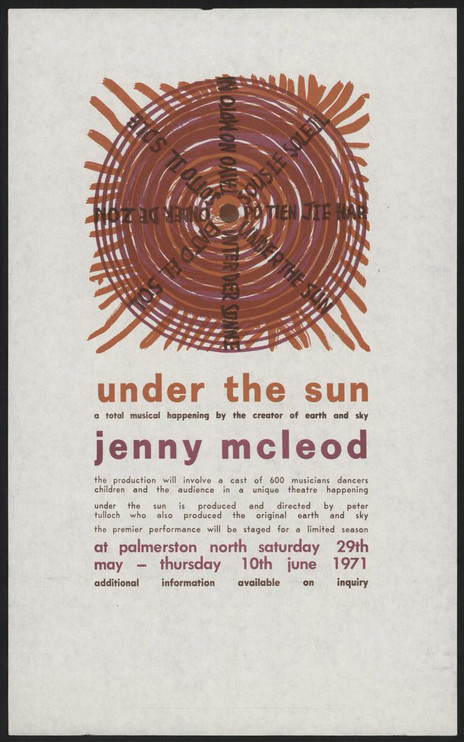
Under the Sun poster, 1971. - Manawatū Heritage
One reason for Jenny’s shifting allegiance was her belief that composers of serious music were failing to reach audiences. “What goes on in serious art today is utterly irrelevant to the way most people live. Pop is not irrelevant … In New Zealand the kids who sing pop music are filling a void left by the lack of serious composers in the country.” To this end she conscripted a local pop band, the Forgiving, to play a leading role in Under the Sun (Garry Hunt, bass guitar; Paul Hunt, bass drums; Garry Powell, organ). They furnished the show with some of the improvised passages called for in the score.
The energy and unscripted qualities of improvisation were further reasons for Jenny’s gradual move away from scored art music and towards popular forms. This was quite a shift for her in terms of the ways she expected her own music to be interpreted.
During the rehearsals for Under the Sun, she began to embrace improvisation, and to accommodate greater freedoms for performers in the music she composed. She told Elizabeth Kerr, “There was a rock group in it and one night we got into a jam session. This was something I’d never done before, I’d never improvised. We went on till three, four in the morning and when I came out of there I felt completely refreshed, renewed in a way, and this had some sort of message in it for me.”
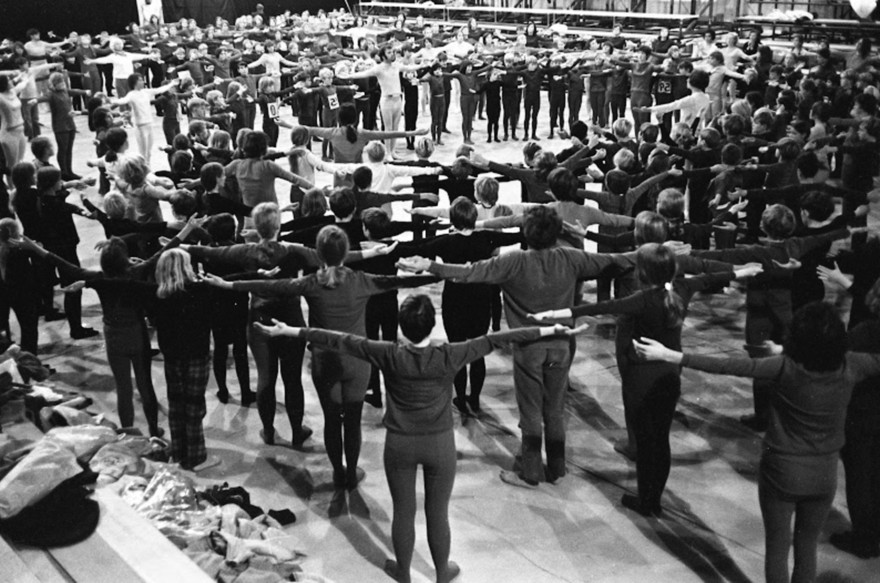
Rehearsal for Jenny McLeod's Under the Sun. - Manawatū Heritage
The experience led her towards a new conception of her work as a composer: “When I think of the whole process of writing down music, the important moments are when you get the idea and when you hear it. In between comes the labour, the realising of an idea on paper. It seems to me it would be better if I could extract that useless middle stuff and throw it away. That’s what rock music and Indian music does. Those two moments are together. The idea and the sound are more or less simultaneous so there’s no dichotomy between knowledge and experience. In western music – the whole of western culture – the things that should be together have become differentiated and broken up.
Jenny was moving towards the idea that composition might evolve from a top-down autocratic model towards a more distributed activity, where all participants were making choices about how the music sounded. Nonetheless, for a work on the scale of Under the Sun, it was still absolutely necessary that most of the music and action be scripted, and she worked closely with the conductors leading the choirs and orchestras, and with director Peter Tulloch.
The show, with a final cast of about 600, was presented in evening performances (with matinees on Saturdays) between 29 May and 10 June 1971, and played to a collected audience of 11,000.
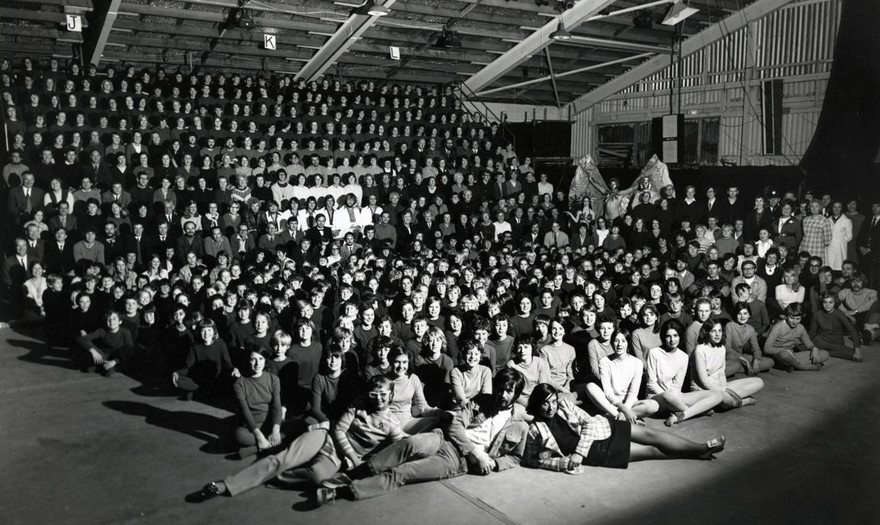
The cast and crew of the Under the Sun stage production. Lying down in front, from left: Morva Croxson, Peter Tulloch (director) and Jenny McLeod (composer). - Manawatū Heritage
Under the Sun is a work in five acts told from the point of view of the last men on Earth. Plangent brass casts dark sonorities over the work’s opening moments, while thundering percussion and hundreds of voices are raised in cries and screams to offer praise to the sun: creator, preserver, destroyer. Dramatic music with a kind of cyclonic energy accompanies descriptions of the birth of the solar system, the formation of the Earth and the emergence of life. The text – pre-recorded and therefore regulating durations during the performance – describes the physical and chemical evolution of Earth and life on it, and is permeated with the kind of scientism that was so prevalent in the early 1970s: sending men to the moon; nuclear power stations; TV shows like Doctor Who and Star Trek. Jenny said, “I have taken the scientific facts and theatre-ised them,” and described the work as “Darwinian to the core”.
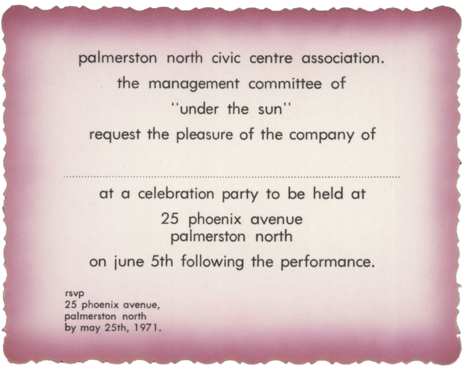
Invitation to the Under the Sun after-party, 25 May 1971. - Manawatū Heritage
Children’s chanting introduces Act Two, which traces the emergence of animals – fish, dinosaurs, birds and mammals, each occasioning a dance sequence – and segues into Act Three which celebrates the arrival of humankind.
A hymn extolling the one true God leads into Act Four, a “kaleidoscopic sequence of the development of man and his accomplishments on the earth”. Electric bass and organ creep into the mix, and drums lay down a boogaloo rhythm while a kind of pop art collage of headlines and advertising messages brings the action up to date. This all culminates with “youth speaks … the whole world dances”. After an interval, the final act tells of population growth, the pollution of the planet and the exploration of space, the accelerating advances of science and nuclear war. Finally, perhaps mercifully, the sun engulfs the Earth.
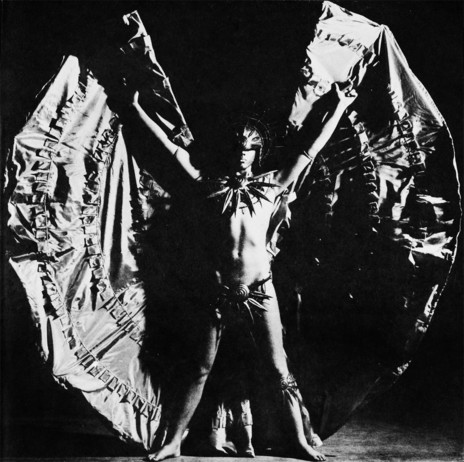
Here comes the Sun King: photo from the Under the Sun programme/booklet
Bruce Greenfield recalled issues with the backing track to which the live performance had to be synced and some technical problems on the first night, but the performances largely went according to plan – a remarkable achievement considering the complexity of the show and the number of performers involved. There were certainly some high points to the production. Morva Croxson retained powerful memories of “The pop group The Forgiving, with Grant Bridger as the singer” going down well, and ‘the appearance of the Sun King, a godlike or Greek statue figure with a gilded body and a sun-ray elaborate headdress – a magnificent sight.”
Greenfield recalled another particularly memorable episode: “There was this moment when everybody danced to bring on the rain. We had a corrugated iron roof in the arena, and at the precise moment of the rain dance – it had been dry and hot for days – this huge deluge came out of nowhere and pounded down on the roof. And it immediately stopped once the rain dance music stopped. It was like a sound effect had been turned on and off by God.”
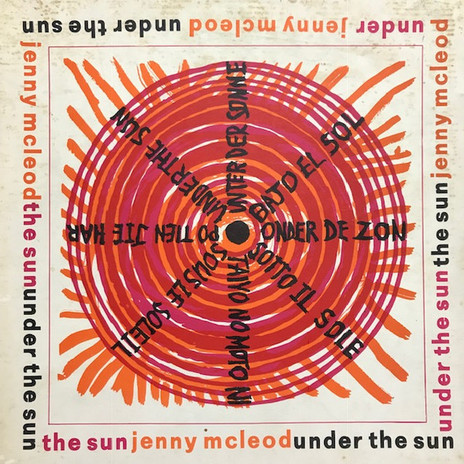
Under the Sun: a 3 LP box set released on Philips NZ in 1971.
The appeal of rock music – and the crossover possibilities
Jenny first actively listened to rock after her return from Europe, and began to play the music a few years later. “But to my surprise,” she said, “I was not very good at it, when I had fairly easily been good at every other kind of music I had met. That presented a new challenge. My sense of rhythm was the weak spot; my own spontaneous rhythms were too old-fashioned.” Playing along with records, and jamming with the musicians in the rock band she had dragooned for Under the Sun, had helped develop her feeling for the music. Subsequently, she “pursued rock for some years with my own band – not commercially, though we did a beach tour – until the idioms had worked themselves into my bones, so that things came naturally and I felt more in tune with the spirit of my time.”
She had an intuition that pop and rock offered something valuable to her own practice as a composer.
As much as Jenny relished the challenges rock music posed for her as a performer, that was not primarily why she was first drawn to the Beatles and the Rolling Stones; she’d listened to the music because she really liked it: “My appreciation was full-blooded and enthusiastic. I danced to it too, sometimes all night long.”
Her sustained engagement with this music during the 1970s had been fuelled by her growing intuition that pop and rock offered something valuable to her own practice as a composer. “I had also sensed,” she said, “the future possibility of a kind of pop-rock crossover classical or art music, which did come to pass, more or less, in my “classical” pop music of the 1980s.” But this was able to occur only once the rock and pop idioms were as natural to her as was the art music she had loved and studied for so long: “Only after I had learned to improvise rock music was I able to compose and write down, if necessary, music in the same idiom. And only after these techniques had become second nature was my unconscious mind then in a position to fuse all this with the rest of the musical know-how inside me, ie, the repository of musical habits acquired from my beloved mentors of the past – Bach, Mozart, Schubert, Chopin and Debussy to name the most important.”
--
An edited extract from Jenny McLeod: A Life in Music by Norman Meehan (Wellington: Te Heranga Waka University Press, 2023)
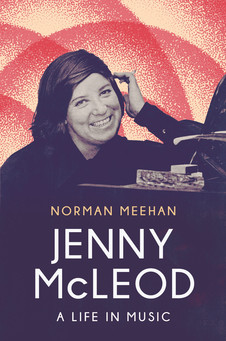
Jenny McLeod: A Life in Music (2023)
--
Further reading / listening:
Full PDF programme of Under the Sun at Manawatū Heritage
Jenny McLeod profile at NZ On Screen
RNZ: Composer of the Week: Jenny McLeod (1941-2022) – an interview recorded in 2001 between composer Jenny McLeod and RNZ Concert’s Tim Dodd on the occasion of her 60th birthday.
Elizabeth Kerr’s tribute to Jenny McLeod on her 80th birthday
Graham Reid reviews Norman Meehan’s biography of Jenny McLeod
The Lilburn Lecture
Jenny McLeod’s 2016 Lilburn Lecture at the National Library was entitled “Prosaic Notes from an Unwritten Journal”. She considered Douglas Lilburn’s thoughts on tradition and language, in combination with her own personal reflections. The lecture was delivered as a prose poem, with about 30 musical extracts from her works. The lecture can be heard at this RNZ link, along with the text of the prose poem.
RNZ: Jenny McLeod: The Lilburn Lecture (2016)
Soundtrack work
--